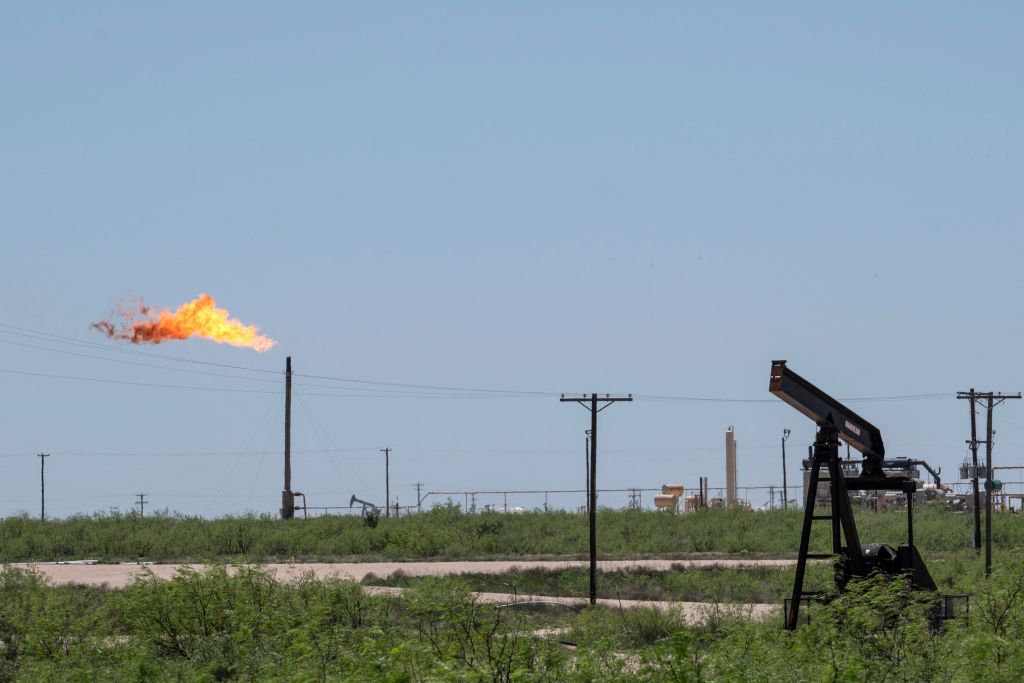
DUBAI, UNITED ARAB EMIRATES — Methane concentrations in the atmosphere are rising, and the oil and gas industry is responsible for nearly a third of global methane emissions. The greenhouse gas is 80 times more powerful than carbon dioxide over its first 20 years in the atmosphere, and it’s responsible for a quarter of the temperature increase that has already taken place. At COP28, the annual United Nations climate conference taking place in Dubai, United Arab Emirates, the United States announced that it has finalized regulations to tackle this pressing problem.
On Saturday, the Environmental Protection Agency finalized a rule to reduce methane emissions from the U.S. oil and gas industry, which is responsible for about 12 percent of global methane emissions from the sector. Methane is the main component of natural gas, and it leaks from every phase of oil and gas production, from extraction to transport to refining. The new rule requires oil field companies to monitor for leaks, fix them promptly, and phase out the practice of burning off natural gas into the atmosphere — a process called flaring. They must also minimize venting, the deliberate release of natural gas, during certain processes. The rule allows third parties, including environmental and watchdog groups, to monitor oil and gas sites and report violations.
The EPA estimates that the long-awaited rule will prevent 58 million tons of methane emissions between 2024 and 2038, the emission reductions equivalent to taking 28 million cars off the road every year. Ali Zaidi, the White House national climate advisor, said the rule will slash almost 2 percent of the country’s greenhouse gas emissions, which the Biden administration has committed to halving by 2030.
The rule will help “close that gap even further and mov[e] us along the trajectory we need to be on,” said Zaidi at a press conference at Expo City in Dubai, where world leaders and climate negotiators have gathered to eke out new climate agreements. “Even as we try to phase out our reliance on fossil fuels, we must work to clean up existing operations rapidly and rigorously, and today’s announcement does just that.”
The International Energy Agency estimates that more than two-thirds of the methane released from fossil fuel operations can be eliminated. The requirements in the new EPA regulation will help achieve those reductions. They’re also expected to have profound effects on public health. Nearly 18 million people live within a mile of an oil and gas field in the U.S., breathing in a host of toxic chemicals that are released along with methane. Proximity to oil and gas sites has been linked to a host of health effects, including lower lung function, high-risk pregnancies, and preterm birth.
“It’s especially important to recognize that a lot of that public health burden in the United States is falling on low-income communities and Black and brown communities,” said Rachel Cleetus, a policy director and lead economist with the nonprofit Union of Concerned Scientists. “On both fronts — public health and climate — this is a win.”

The Biden administration’s rule is one of several methane-related announcements at COP28. Separately, COP28 president Sultan Al-Jaber, who is also the head of the UAE’s national oil company, announced that 50 oil companies responsible for 40 percent of global oil production had signed onto a pledge to reduce emissions directly tied to their operations by 90 percent. The companies include ExxonMobil, Shell, and BP, as well as the national oil companies of Saudi Arabia, UAE, Brazil, and about two dozen other countries. Al-Jaber has positioned himself as a dealmaker who can bring oil and gas companies to the table and convince them to make or strengthen climate pledges. “Methane is the low-hanging fruit,” said Al-Jaber at a summit announcing the pledges. “It is an easy and quick way.”
In concert, the International Energy Agency, the United Nations Environment Programme, Bloomberg Philanthropies, and a group of other nonprofit organizations launched a new effort to track oil and gas companies’ methane emissions. The Environmental Defense Fund, a nonprofit that has produced a body of research on methane emissions from the oil and gas sector, is planning to launch a $90 million satellite that will detect emissions from fossil fuel production sites around the world. Data from the satellite will be made available “to every human on the planet who has access to the Internet,” Fred Krupp, president of the Environmental Defense Fund, said on a press call.
“We need comprehensive, real-time awareness of specific sources of methane,” Krupp said. “Getting that information is indispensable for holding the oil and gas industry accountable for the pledges that they’ve made.”
Other environmental groups have dismissed such pledges as “a trojan horse for Big Oil and Gas greenwash” because none of the corporate commitments announced so far address the emissions that come from burning fossil fuels. Cleetus, the Union of Concerned Scientists economist, warned that corporate commitments are voluntary and inadequate. “This is an industry that has actively fought against climate action,” she said.
Get caught up on COP28
Companies have an economic incentive to cut methane emissions. The natural gas that doesn’t leak away can be used to power equipment on-site or sold on the market. In fact, the EPA expects an estimated $820 to $980 million worth of natural gas will be recovered each year as a result of its new rule. Jason Arceneaux, president of ARC Energy, a Louisiana-based company that works with oil and gas companies to reduce methane emissions, told Grist that operators are increasingly seizing those cost savings. They’re also responding to market signals, he said.
“The ultimate belief of a lot of industry is that there’s going to be carbon footprint measurements,” said Arceneaux. “Some of the customers in Europe and others are wanting those measurements, and so I think customers are driving that decision.”
This is the first year since the Paris Agreement was ratified in 2016 that countries are formally measuring their progress against the climate goals they agreed to — a process referred to as “global stocktake” in negotiation parlance. Most countries’ commitments only quantify carbon dioxide reductions, but negotiators are beginning to raise the need to include specific targets for methane and other greenhouse gases in national emission reduction pledges.
The EPA’s methane rule is also being finalized as climate negotiators hash out whether all 198 countries party to the United Nations Framework Convention on Climate Change can agree to language on transitioning away from fossil fuels. Options include “phasing out” or “phasing down” fossil fuel use or the “substitution” of renewables for fossil fuels.
“We can’t at this moment when the climate crisis is spiraling out of control avoid addressing the root cause,” said Cleetus. “It’s not just emissions, but it’s the use of fossil fuels, and we can’t dodge that issue. That’s the crux of it.”





